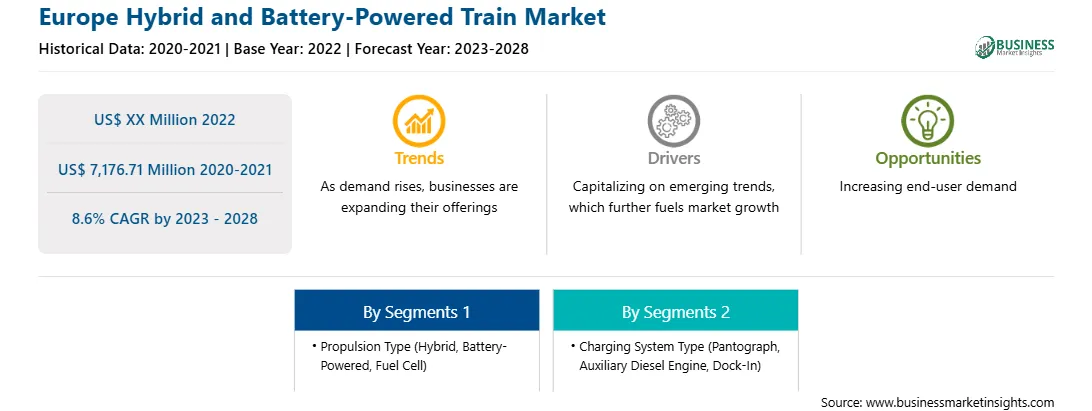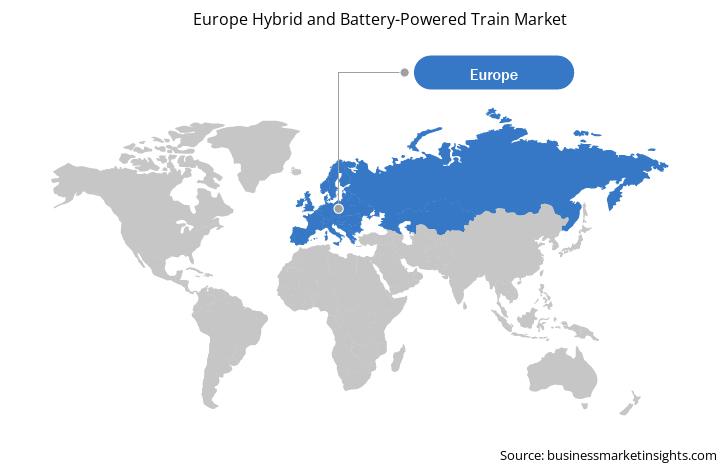The increasing demand for energy-efficient transportation is driving the hybrid and battery-powered train market. Governments of various European countries are taking initiatives to reduce carbon emissions. The European Union (EU) has adopted the United Nations (UN) 2030 agenda for sustainable development and the Paris Agreement on climate change. Furthermore, the European Green Deal is a part of the European Commission's strategy to implement the UN 2030 agenda and the Sustainable Development Goals (SDGs). EU is implementing these plans and policies to achieve climate neutrality by 2050. Through this Green Deal, the European Commission is aiming to reduce transport emissions by 90% by 2050. To achieve the goal of reducing carbon emissions, governments of various European countries are adopting fuel-efficient trains, driving the Europe hybrid and battery-powered train market growth.
The pantograph charging system is located on the roof of the train; it helps collect the electricity needed to power the train. Pantographs make direct contact with the overhead power lines in order to obtain electricity. The system provides fast charging with a wide range of power levels, thus, providing an uninterrupted power supply in the train. Pantograph based battery trains from the market players will fuel the segment's growth during the forecast period, promoting the overall Europe hybrid and battery-powered train market growth.
A hybrid train is an energy-saving system that is a combination of a conventional diesel and electric drive system. The train comprises a generator with a combustion engine, one or more electric motors with corresponding power electronics, and a battery. As the hybrid train helps reduce greenhouse gases and other exhaust gas emissions in the environment, its demand in the market is increasing. In addition, the use of a combustion engine as a generator in the hybrid train can help maximize the working time of a combustion engine, thus, improving the efficiency of the entire system by up to 30%. All the above advantages of hybrid trains are increasing their adoption in the market tremendously. Battery-powered trains are one of the cleanest zero-emission solutions. Adopting these trains will help achieve climate change targets by improving air quality in cities and non-electrified stations. Battery-powered trains will also allow traveling beyond electrified routes, providing a seamless journey and an integrated passenger experience that benefits both operators and the environment. Due to all the above benefits of battery-powered trains, their demand is increasing in the region, pushing Europe hybrid and battery-powered train market players to develop innovative products.
The Europe hybrid and battery-powered train market is segmented based on propulsion type, charging system type, and geography. Based on propulsion type, the Europe hybrid and battery-powered train market is segmented into hybrid, battery-powered, and fuel cell. Based on charging system type, the Europe hybrid and battery-powered train market is segmented into pantograph, auxiliary diesel engine, and dock-in. By geography, the Europe hybrid and battery-powered train market is segmented into Germany, France, Italy, Spain, the UK, Poland, Austria, Slovenia, Bulgaria, Hungary, Romania, Greece, Serbia, Scandinavia, Croatia, and the Rest of Europe.
Alstom SA, Westinghouse Air Brake Technologies Corp, Construcciones y Auxiliar de Ferrocarriles SA, Končar Electrical Industry Inc, Hitachi Rail STS SpA, Hyundai Rotem Co, Siemens Mobility GmbH, CRRC Corp Ltd, Toshiba Infrastructure Systems and Solutions Corporation, and Stadler Rail AG are among the key Europe hybrid and battery-powered train market players operating in the market and profiled in this study.
The overall Europe hybrid and battery-powered train market size has been derived using both primary and secondary sources. Exhaustive secondary research has been conducted using internal and external sources to obtain qualitative and quantitative information related to the Europe hybrid and battery-powered train market. The process also helps obtain an overview and forecast of the market with respect to all the market segments. Also, multiple primary interviews have been conducted with industry participants to validate the data and gain analytical insights. This process includes industry experts such as VPs, business development managers, market intelligence managers, and national sales managers, along with external consultants such as valuation experts, research analysts, and key opinion leaders, specializing in the Europe hybrid and battery-powered train market.
Strategic insights for the Europe Hybrid and Battery-Powered Train provides data-driven analysis of the industry landscape, including current trends, key players, and regional nuances. These insights offer actionable recommendations, enabling readers to differentiate themselves from competitors by identifying untapped segments or developing unique value propositions. Leveraging data analytics, these insights help industry players anticipate the market shifts, whether investors, manufacturers, or other stakeholders. A future-oriented perspective is essential, helping stakeholders anticipate market shifts and position themselves for long-term success in this dynamic region. Ultimately, effective strategic insights empower readers to make informed decisions that drive profitability and achieve their business objectives within the market.

| Report Attribute | Details |
|---|---|
| Market size in 2022 | US$ XX Million |
| Market Size by 2028 | US$ 7,176.71 Million |
| CAGR (2023 - 2028) | 8.6% |
| Historical Data | 2020-2021 |
| Forecast period | 2023-2028 |
| Segments Covered |
By Propulsion Type
|
| Regions and Countries Covered | Europe
|
| Market leaders and key company profiles |
|
The geographic scope of the Europe Hybrid and Battery-Powered Train refers to the specific areas in which a business operates and competes. Understanding local distinctions, such as diverse consumer preferences (e.g., demand for specific plug types or battery backup durations), varying economic conditions, and regulatory environments, is crucial for tailoring strategies to specific markets. Businesses can expand their reach by identifying underserved areas or adapting their offerings to meet local demands. A clear market focus allows for more effective resource allocation, targeted marketing campaigns, and better positioning against local competitors, ultimately driving growth in those targeted areas.

The Europe Hybrid and Battery-Powered Train Market is valued at US$ XX Million in 2022, it is projected to reach US$ 7,176.71 Million by 2028.
As per our report Europe Hybrid and Battery-Powered Train Market, the market size is valued at US$ XX Million in 2022, projecting it to reach US$ 7,176.71 Million by 2028. This translates to a CAGR of approximately 8.6% during the forecast period.
The Europe Hybrid and Battery-Powered Train Market report typically cover these key segments-
The historic period, base year, and forecast period can vary slightly depending on the specific market research report. However, for the Europe Hybrid and Battery-Powered Train Market report:
The Europe Hybrid and Battery-Powered Train Market is populated by several key players, each contributing to its growth and innovation. Some of the major players include:
The Europe Hybrid and Battery-Powered Train Market report is valuable for diverse stakeholders, including:
Essentially, anyone involved in or considering involvement in the Europe Hybrid and Battery-Powered Train Market value chain can benefit from the information contained in a comprehensive market report.